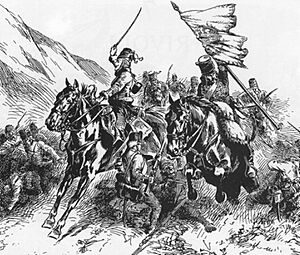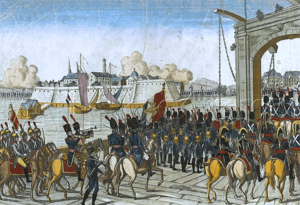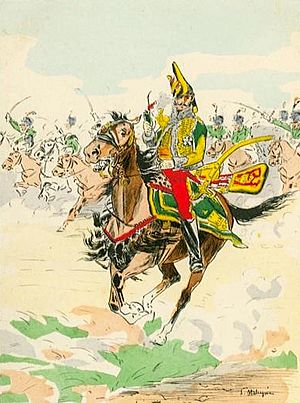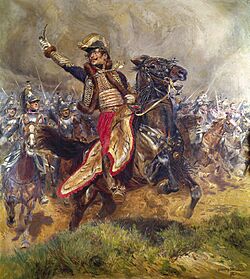Antoine Charles Louis de Lasalle facts for kids
Quick facts for kids
Antoine-Charles-Louis, Comte de Lasalle
|
|
|---|---|

Portrait by Antoine-Jean Gros, 1808
|
|
| Born | 10 May 1775 Metz, Kingdom of France |
| Died | 6 July 1809 (aged 34) Deutsch-Wagram, Austrian Empire |
| Allegiance | |
| Service/ |
French Army |
| Years of service | 1786–1809 |
| Rank | General de division |
| Battles/wars | French Revolutionary Wars Napoleonic Wars † |
Antoine-Charles-Louis, Comte de Lasalle (10 May 1775 – 6 July 1809) was a brave French cavalry general. He fought during the French Revolution and the Napoleonic Wars. People often called him "The Hussar General" because of his daring style. He became famous for his role in the Capitulation of Stettin. Lasalle was known for his many exciting adventures and fought in battles all over Europe. He sadly died during the Battle of Wagram.
Contents
Early Life and Military Start
Antoine Lasalle was born on May 10, 1775, in Metz, France. His family was part of the lower nobility. His father was an officer in the French Royal Army. Antoine showed an interest in the military from a young age. When he was just eleven, he joined an infantry regiment. By age fourteen, he was a second lieutenant.
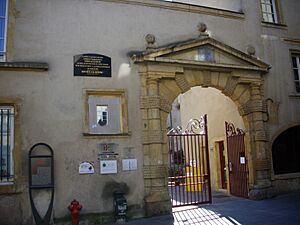
When the French Revolution began, Lasalle supported it. However, a new rule in 1792 stopped people from noble families from being officers. So, he lost his rank. But Lasalle remained loyal to France. He still wanted a military career. In 1792, he joined the army as a private soldier. He then moved to Paris. He joined a group of revolutionaries called the Section des Piques. By 1793, he was a volunteer in the 23rd Horse Chasseur Regiment. He fought with the Army of the North in Italy.
Fighting in Italy
Thanks to a family friend, François Christophe Kellermann, Lasalle got his officer rank back. He became Kellermann's assistant on March 10, 1795. He enjoyed the work of planning and organizing military actions. He stayed with Kellermann when they moved to the Army of Italy. Lasalle was promoted to Captain on November 7, 1796.
Battle of Rivoli: Lasalle's Daring Charge
Lasalle proved his bravery at the Battle of Rivoli. He charged forward with only 26 horsemen from the 22nd Horse Chasseurs. French cannons fired at the Austrian soldiers. Two groups of French infantry attacked, supported by cavalry led by Leclerc and Lasalle. The Austrian soldiers panicked and fled. Many Austrian soldiers gave up. Lasalle and his men continued to support the French generals until the battle ended.
The French had about 5,000 casualties. The Austrians had 14,000. Lasalle captured five enemy flags himself. After the battle, all the captured flags were placed before Napoleon. Lasalle was resting on top of his five flags. Napoleon told him, "Go to sleep on your flags, Lasalle, for it was well-deserved!”
The Invasion of Egypt
Napoleon Bonaparte personally asked Lasalle to join the campaign in Egypt. Lasalle was excited to go. He joined the Army of the East. They invaded Alexandria and then marched to Cairo. On July 21, 1798, at the Battle of the Pyramids, the Turkish army resisted. Lasalle, leading 60 men, charged the village and defeated the enemy. He cut off the retreating army by taking a secret path near the Giza Pyramids. This allowed Napoleon to defeat his opponents. Because of this brave action, Napoleon promoted Lasalle to Lieutenant Colonel.
A Short Break in France
Lasalle married Joséphine Berthier. She was the wife of General Victor Leopold Berthier. Napoleon gave Lasalle money for his wedding. When they met, Napoleon asked about the wedding. Lasalle joked that he needed more money for gifts and furniture. Napoleon had given him money the week before. Lasalle admitted he had used it to pay debts and lost the rest. This kind of honesty would usually cause trouble for a soldier. But Napoleon just smiled. He ordered his aide, General Géraud Duroc, to give Lasalle more money. When someone asked why Napoleon didn't punish Lasalle, Napoleon said, "It only takes a stroke of a pen to create a prefect, but it takes twenty years to make a Lasalle."
Fighting on the Prussian Front
Lasalle immediately fought at the Battle of Austerlitz. He was with the 1st Dragoon Division. Because of his success, he was given command of a Light Cavalry Brigade. This brigade included the 5th and 7th Hussar Regiments. Lasalle became very famous during the 1806 campaign in Prussia. His hussars became known as the "Brigade Infernale" ("Hellish Brigade").
He then fought at Schleiz and Jena-Auerstedt. There, he captured the King of Prussia's bodyguard. He also forced the Prince of Hohenlohe to retreat. On October 26, 1806, Lasalle was chasing Hohenlohe. He saw Prussian infantry near a forest. Even though the enemy had many more soldiers, he charged. After tough fighting, the Prussians pushed back Lasalle's hussars. But then, more French cavalry arrived. General Grouchy joined the attack. Their combined forces defeated the Prussian cavalry. The Prussian infantry then retreated into the woods.
On October 28, they reached Prenzlau. They realized the Prussian Army was already inside the city. Marshal Murat ordered Lasalle to attack the northern gates. Lasalle rode his troopers right up to the gates and broke them open. He rode through the city and out the east gates. From there, he saw Hohenlohe's army forming on a plain.
The Capture of Stettin
The next day, Lasalle and his hussars marched to the fortress of Stettin. They arrived long before the main French army. Lasalle decided to try a trick. He pretended that the entire French army had arrived. He demanded that Stettin surrender. General Romberg refused at first. Lasalle then threatened to bombard the town and attack with 50,000 men. He said the town would be plundered. Believing he faced a huge army, Romberg agreed to surrender. Stettin surrendered on the evening of October 29–30.
Battles of Lübeck and Golymin
The surrender of Stettin stopped Prussian General Blücher from escaping. Blücher was determined to get away from the French. Murat, Lasalle, Bernadotte, and Soult chased him. They forced Blücher farther north. On November 5, Blücher entered the neutral city of Lübeck. He demanded money and food. The next day, Bernadotte's men arrived and attacked the city walls. Lasalle fought bravely in this battle.
During the Battle of Golymin, General Lasalle led his "Hellish Brigade" against Russian cannons. The hussars charged but suddenly panicked. They turned and ran back in disorder. Only a small group of the 7th Hussars stayed with Lasalle. Lasalle was furious. He rode after them, yelled "Halt!", and brought them back. He made them stand close to the Russian guns as punishment. He stood 20 paces in front of his men, calm under enemy fire.
He then gathered his troops again. With support from other cavalry, he charged the enemy from the side. The Russians were defeated and fled. Lasalle chased them until the battle was won.
Promotion and Training the Polish Cavalry
On December 30, 1806, Lasalle was promoted to Divisional General. He was given command of the Light Cavalry Division. Soon after, Napoleon allowed a new Polish Light Horse regiment to be formed. Under General Lasalle, they received intense training in horsemanship and discipline. They became one of the best regiments in the Imperial Guard. An officer wrote that they learned a lot from Lasalle. He said Lasalle had all the qualities of a great leader.
Battle of Heilsberg: Saving Murat
During the Battle of Heilsberg on June 12, 1807, Marshal Murat was surrounded by 12 Russian dragoons. Lasalle, commanding three brigades of light cavalry, saw Murat in danger. He charged the enemy, killing the officer leading the Russians. He made the other 11 dragoons flee, saving Murat's life. Soon after, Murat and others saved Lasalle from danger. Murat told Lasalle, "General, we are even." The next month, Napoleon made Lasalle a Grand Cross Knight. He was then sent to Spain.
The Peninsular War
Lasalle was given command of the 1st Light Cavalry Division. His cousin, Pierre-Louis-Adolphe-Georges du Prel, became his assistant. Lasalle arrived in Spain on February 15, 1808. Lasalle was known for being harsh when people resisted. It was said he "made Spain tremble." In June, Lasalle was responsible for burning Torquemada. This village had resisted his troops. As his men approached Palencia, the rebels fled to Valladolid.
Battling Across Spain
After taking supplies from Torquemada and getting money from Palencia, Lasalle went to Valladolid. On June 11, 1808, Lasalle's army joined with General Merle's troops. The next day, their combined army of 9,000 men attacked 4,000-5,000 Spanish soldiers. The Spanish, led by General Cuesta, were blocking the road to Burgos at the Cabezón bridge. In the French attack, the Spanish cavalry fled, and their infantry broke apart. Lasalle then went to Valladolid and occupied it that night.
On July 14, at Medina de Rioseco, Lasalle fought with 14,000 men against over 20,000 Spaniards. Lasalle marched towards Vitoria, protecting the French army from enemy attacks. Because of these actions, he was made a Grand Officer of the Legion of Honor. He also became a Count of the Empire.
On November 7, he fought at the Battle of Burgos. The untrained Spanish soldiers could not stand against the French cavalry and scattered. A few days later, at the Battle of Villa Viejo, he captured seven cannons and four flags. On March 15, Lasalle's cavalry crossed the Tagus River at Talavera. Two days later, Lasalle reached Meza de Ibor. He fought the Spanish troops there, forcing them out of their defensive position.
Battle of Medellín: A Decisive Victory
Lasalle then joined the Battle of Medellín. The Spanish army was almost twice the size of the French. Lasalle's position was risky because the Guadiana River was right behind him. He knew a retreat would be dangerous across the narrow bridge. But Lasalle had received more infantry soldiers. When he saw the Spanish fleeing, he ordered a strong counter-attack. He also attacked from the front. Soon, his French dragoons were crushing the center of the Spanish army. The Spanish army was almost completely destroyed.
Final Battles in Austria
Battle of Aspern-Essling: Scouting and Charging
Lasalle joined the French Army for its 1809 campaign along the Danube. He arrived just before Napoleon's push across the Danube at Aspern-Essling. He was sent to find the Austrian army. The operation began on May 13, 1809. They built a bridge of boats over the Danube to Lobau. Then, Lasalle's light cavalry crossed into Lobau. As soon as the bridge was finished, Lasalle's horsemen spread out into the plain. There were no travelers or messengers to stop, so Lasalle's officers had to rely on what they saw and heard.
On the morning of May 21, many soldiers, guns, and wagons were on the island. Over the next four hours, the villages of Aspern and Essling were captured and recaptured many times. Napoleon ordered Lasalle's cavalry to help other French troops. But General Liechtenstein attacked Lasalle with nine regiments. Lasalle fought them off, buying time for the French infantry.
At 7 p.m., Lasalle gathered his troops for another charge. Lasalle defeated the first Austrian line. But Austrian hussars captured some of his men. On the second day, the French were outnumbered. Napoleon ordered Lasalle and Espagne to defend a key area. Lasalle's men used the fog to their advantage. They fought between the two villages, making short, quick charges. These attacks stopped the Austrians from launching a big attack. This allowed General Boudet to take full control of Essling.
Later, Lasalle's cavalry charged at least three times to support the infantry. Even though the French had to retreat, Lasalle's bravery stopped the retreat from becoming a complete defeat.
Death at the Battle of Wagram
On July 5, 1809, Lasalle fought at the Battle of Wagram. He commanded a Light Cavalry Division. On the night of the second day, Lasalle's men had not yet been ordered to fight. Lasalle went to Marshal Masséna to ask for permission to chase the enemy. But Masséna told him to help General MacDonald instead. Lasalle was separated from his division. When he accidentally came across an enemy infantry group, he charged them with the 1st Cuirassier Regiment. Lasalle was shot in the chest but kept charging. The enemy infantry broke and fled. But as Lasalle continued to charge, he was shot between the eyes by a Hungarian grenadier. He died instantly. Another general tried to get revenge for Lasalle. He led a hussar regiment against the Austrian infantry. But he was wounded and had to be carried away.
Honors After His Death
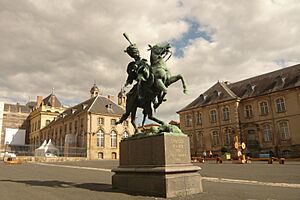
- A street in Metz was named after him.
- His portrait was placed in one of the salons of the Hotel de Ville in Paris.
- In 1891, his remains were brought back from Austria. They were buried at Les Invalides, a famous military museum in Paris.
- In 1893, a statue of him on horseback was put up in Lunéville.
- He has a bust (a sculpture of his head and shoulders) in the Gallery of Battles at the Palace of Versailles.
- His name is carved on a pillar of the Arc de Triomphe in Paris.
- His name is used for a cycling event in the Netherlands, the Tour de Lasalle.
- He is briefly mentioned in a short story by Edgar Allan Poe, "The Pit and the Pendulum". In the story, he saves a character from being executed.


